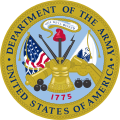Файл:Emblem of the U.S. Department of the Army.svg

Размер этого PNG-превью для исходного SVG-файла: 500 × 500 пкс. Другие разрешения: 240 × 240 пкс | 480 × 480 пкс | 768 × 768 пкс | 1024 × 1024 пкс | 2048 × 2048 пкс.
Исходный файл (SVG-файл, номинально 500 × 500 пкс, размер файла: 141 Кб)
История файла
Нажмите на дату/время, чтобы посмотреть файл, который был загружен в тот момент.
| Дата/время | Миниатюра | Размеры | Участник | Примечание | |
|---|---|---|---|---|---|
| текущий | 22:39, 20 ноября 2016 |  | 500 × 500 (141 Кб) | Corkythehornetfan | reduce |
| 13:31, 23 сентября 2006 |  | 500 × 500 (252 Кб) | Madden | * SEAL OF THE DEPARTMENT OF THE ARMY ==Background:== * The traditional seal used during and since the Revolution was redesignated as the Seal of the Department of the Army by the National Security Act of 1947. * The Department of the Army seal is author |
Использование файла
Следующие 3 страницы используют этот файл:
Глобальное использование файла
Данный файл используется в следующих вики:
- Использование в bn.wikipedia.org
- Использование в bs.wikipedia.org
- Использование в ca.wikipedia.org
- George Patton
- Courtney Hodges
- Omar Bradley
- 5è Exèrcit (Estats Units)
- Lloyd Fredendall
- 101a Divisió Aerotransportada
- James Gavin
- Joseph Lawton Collins
- Maxwell Taylor
- Lewis H. Brereton
- Setè de cavalleria
- William Childs Westmoreland
- 2n Batalló de Rangers (Estats Units)
- Forces Aèries de l'Exèrcit dels Estats Units
- 82a Divisió Aerotransportada
- Ministeris federals dels Estats Units
- Norman Schwarzkopf
- Fred Livingood Walker
- Usuari:PereBot/paràmetres plantilles/Infotaula biografia militar
- Exèrcit Central dels Estats Units
- 4a Divisió d'Infanteria (Estats Units)
- Использование в de.wikipedia.org
- Pentagon
- United States Navy
- United States Air Force
- Streitkräfte der Vereinigten Staaten
- United States Army
- Air Force One
- United States Coast Guard
- United States Marine Corps
- Verteidigungsministerium der Vereinigten Staaten
- Vorlage:Navigationsleiste Streitkräfte der Vereinigten Staaten
- Marine One
- Sikorsky S-55
- Piasecki H-21
- MARPAT
- Army Combat Uniform
- Liste der Flaggen der Vereinigten Staaten
- United States Department of the Navy
- United States Department of the Army
- United States Department of the Air Force
- Vorlage:Navigationsleiste Streitkräfteressorts des Verteidigungsministeriums der Vereinigten Staaten
- Navy One
Просмотреть глобальное использование этого файла.


